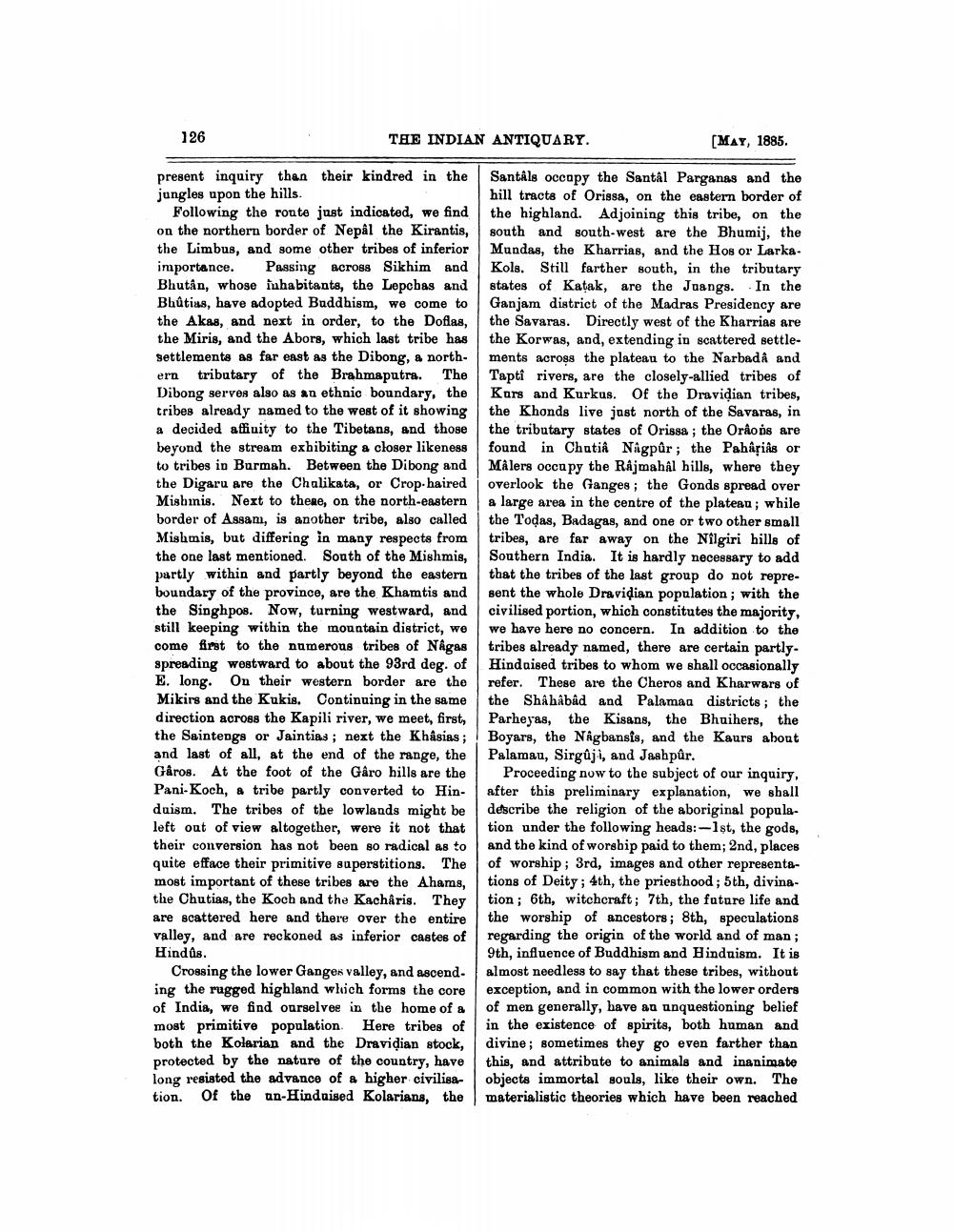________________
126
THE INDIAN ANTIQUARY.
[MAY, 1885.
present inquiry than their kindred in the jungles upon the hills.
Following the route just indicated, we find on the northern border of Nepal the Kirantis, the Limbus, and some other tribes of inferior importance. Passing across Sikhim and Bhutan, whose inhabitants, the Lepebas and Bhútius, have adopted Buddhism, we come to the Akas, and next in order, to the Doflas, the Miris, and the Abors, which last tribe has settlements as far east as the Dibong, a northern tributary of the Brahmaputra. The Dibong serves also as an ethnic boundary, the tribes already named to the west of it showing a decided affinity to the Tibetans, and those beyond the stream exhibiting a closer likeness to tribes in Barmah. Between the Dibong and the Digaru are the Chalikata, or Crop-haired Misbinis. Next to these, on the north-eastern border of Assam, is another tribe, also called Mishmis, but differing in many respects from the one last mentioned. South of the Mishmis, partly within and partly beyond the eastern boundary of the province, are the Khamtis and the Singhpos. Now, turning westward, and still keeping within the mountain district, we come first to the numerous tribes of Nagas spreading westward to about the 93rd deg. of E. long. On their western border are the Mikirs and the Kukis. Continuing in the same direction across the Kapili river, we meet, first, the Saintengs or Jaintias; next the Khasias ; and last of all, at the end of the range, the Gåros. At the foot of the Gâro hills are the Pani-Koch, a tribe partly converted to Hinduism. The tribes of the lowlands might be left out of view altogether, were it not that their conversion has not been so radical as to quite efface their primitive superstitions. The most important of these tribes are the Ahams, the Chutias, the Koch and the Kachåris. They are scattered here and there over the entire valley, and are reckoned as inferior castes of Hindus.
Crossing the lower Ganges valley, and ascend. ing the rugged highland which forms the core of India, we find ourselves in the home of a most primitive population. Here tribes of both the Kolarian and the Dravidian stock, protected by the nature of the country, have long resisted the advance of a higher civilisa- tion. Of the an-Hindaised Kolarians, the
Santâls occopy the Santal Parganas and the hill tracts of Orissa, on the eastern border of the highland. Adjoining this tribe, on the south and south-west are the Bhumij, the Mundas, the Kharrias, and the Hos or Larka. Kols. Still farther south, in the tributary states of Katak, are the Juangs. In the Ganjam district of the Madras Presidency are the Savaras. Directly west of the Kharrias are the Korwas, and, extending in scattered settlements across the plateau to the NarbadA and Tapti rivers, are the closely-allied tribes of Kurs and Kurkus. Of the Dravidian tribes, the Khonds live just north of the Savaras, in the tributary states of Orissa; the Oråo ns are found in Chatiâ Nigpůr; the Paharias or Målers occupy the Rajmahal hills, where they overlook the Ganges; the Gonds spread over a large area in the centre of the platean; while the Todas, Badagas, and one or two other small tribes, are far away on the Nilgiri hills of Southern India. It is hardly necessary to add that the tribes of the last group do not represent the whole Dravidian population; with the civilised portion, which constitutes the majority, we have here no concern. In addition to the tribes already named, there are certain partlyHindaised tribes to whom we shall occasionally refer. These are the Cheros and Kharwars of the Shảhâbâd and Palaman districts; the Parheyas, the Kisans, the Bhuihers, the Boyars, the Någbansis, and the Kaurs about Palamau, Sirguji, and Jashpûr.
Proceeding now to the subject of our inquiry, after this preliminary explanation, we shall describe the religion of the aboriginal population under the following heads:-1st, the gods, and the kind of worship paid to them; 2nd, places of worship; 3rd, images and other representations of Deity; 4th, the priesthood ; 5th, divination; 6th, witchcraft; 7th, the future life and the worship of ancestors; 8th, speculations regarding the origin of the world and of man; 9th, influence of Buddhism and Hinduism. It is almost needless to say that these tribes, without exception, and in common with the lower orders of men generally, have an unquestioning belief in the existence of spirits, both human and divine; sometimes they go even farther than this, and attribute to animals and inanimate objects immortal souls, like their own. The materialistic theories which have been reached




